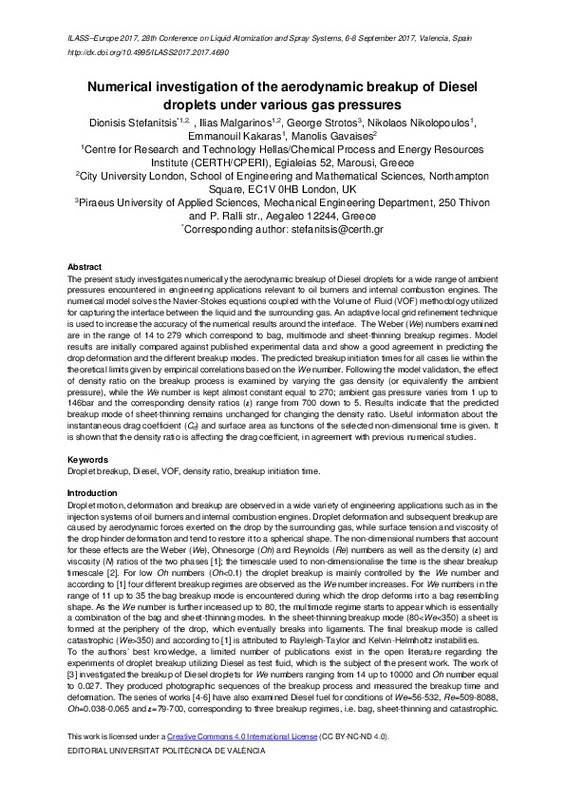JavaScript is disabled for your browser. Some features of this site may not work without it.
Buscar en RiuNet
Listar
Mi cuenta
Estadísticas
Ayuda RiuNet
Admin. UPV
Numerical investigation of the aerodynamic breakup of diesel droplets under various gas pressures
Mostrar el registro sencillo del ítem
Ficheros en el ítem
| dc.contributor.author | Stefanitsis, Dionisis
|
es_ES |
| dc.contributor.author | Malgarinos, Ilias
|
es_ES |
| dc.contributor.author | Strotos, George
|
es_ES |
| dc.contributor.author | Nikolopoulos, Nikolaos
|
es_ES |
| dc.contributor.author | Kakaras, Emmanouil
|
es_ES |
| dc.contributor.author | Gavaises, Manolis
|
es_ES |
| dc.date.accessioned | 2018-04-11T11:29:01Z | |
| dc.date.available | 2018-04-11T11:29:01Z | |
| dc.date.issued | 2017-07-28 | |
| dc.identifier.isbn | 9788490485804 | |
| dc.identifier.uri | http://hdl.handle.net/10251/100217 | |
| dc.description.abstract | [EN] Abstract The present study investigates numerically the aerodynamic breakup of Diesel droplets for a wide range of ambient pressures encountered in engineering applications relevant to oil burners and internal combustion engines. The numerical model solves the Navier-Stokes equations coupled with the Volume of Fluid (VOF) methodology utilized for capturing the interface between the liquid and the surrounding gas. An adaptive local grid refinement technique is used to increase the accuracy of the numerical results around the interface. The Weber (We) numbers examined are in the range of 14 to 279 which correspond to bag, multimode and sheet-thinning breakup regimes. Model results are initially compared against published experimental data and show a good agreement in predicting the drop deformation and the different breakup modes. The predicted breakup initiation times for all cases lie within the theoretical limits given by empirical correlations based on the We number. Following the model validation, the effect of density ratio on the breakup process is examined by varying the gas density (or equivalently the ambient pressure), while the We number is kept almost constant equal to 270; ambient gas pressure varies from 1 up to 146bar and the corresponding density ratios (ε) range from 700 down to 5. Results indicate that the predicted breakup mode of sheet-thinning remains unchanged for changing the density ratio. Useful information about the instantaneous drag coefficient (Cd) and surface area as functions of the selected non-dimensional time is given. It is shown that the density ratio is affecting the drag coefficient, in agreement with previous numerical studies. | es_ES |
| dc.description.sponsorship | Financial support from the MSCA-ITN-ETN of the European Union’s H2020 programme, under REA grant agreement n. 675676 is acknowledged. | es_ES |
| dc.format.extent | 8 | es_ES |
| dc.language | Inglés | es_ES |
| dc.publisher | Editorial Universitat Politècnica de València | es_ES |
| dc.relation.ispartof | Ilass Europe. 28th european conference on Liquid Atomization and Spray Systems | es_ES |
| dc.rights | Reconocimiento - No comercial - Sin obra derivada (by-nc-nd) | es_ES |
| dc.subject | Droplet breakup | es_ES |
| dc.subject | Diesel | es_ES |
| dc.subject | VOF | es_ES |
| dc.subject | Density ratio | es_ES |
| dc.subject | Breakup initiation time | es_ES |
| dc.title | Numerical investigation of the aerodynamic breakup of diesel droplets under various gas pressures | es_ES |
| dc.type | Capítulo de libro | es_ES |
| dc.type | Comunicación en congreso | es_ES |
| dc.identifier.doi | 10.4995/ILASS2017.2017.4690 | |
| dc.relation.projectID | info:eu-repo/grantAgreement/EC/H2020/675676/EU/Holistic Approach of Spray Injection through a Generalized Multi-phase Framework/ | es_ES |
| dc.rights.accessRights | Abierto | es_ES |
| dc.description.bibliographicCitation | Stefanitsis, D.; Malgarinos, I.; Strotos, G.; Nikolopoulos, N.; Kakaras, E.; Gavaises, M. (2017). Numerical investigation of the aerodynamic breakup of diesel droplets under various gas pressures. En Ilass Europe. 28th european conference on Liquid Atomization and Spray Systems. Editorial Universitat Politècnica de València. 1052-1059. https://doi.org/10.4995/ILASS2017.2017.4690 | es_ES |
| dc.description.accrualMethod | OCS | es_ES |
| dc.relation.conferencename | ILASS2017 - 28th European Conference on Liquid Atomization and Spray Systems | es_ES |
| dc.relation.conferencedate | September 06-08,2017 | es_ES |
| dc.relation.conferenceplace | Valencia, Spain | es_ES |
| dc.relation.publisherversion | http://ocs.editorial.upv.es/index.php/ILASS/ILASS2017/paper/view/4690 | es_ES |
| dc.description.upvformatpinicio | 1052 | es_ES |
| dc.description.upvformatpfin | 1059 | es_ES |
| dc.type.version | info:eu-repo/semantics/publishedVersion | es_ES |
| dc.relation.pasarela | OCS\4690 | es_ES |
| dc.contributor.funder | European Commission | es_ES |








